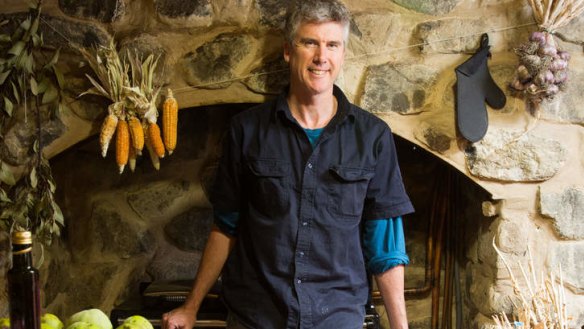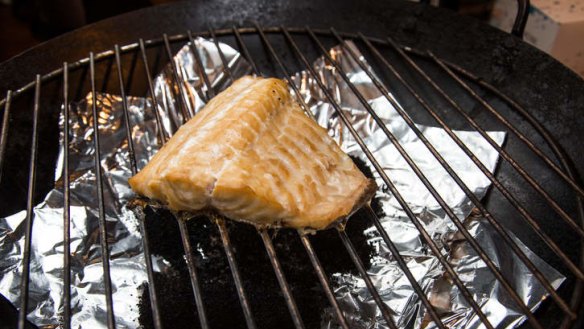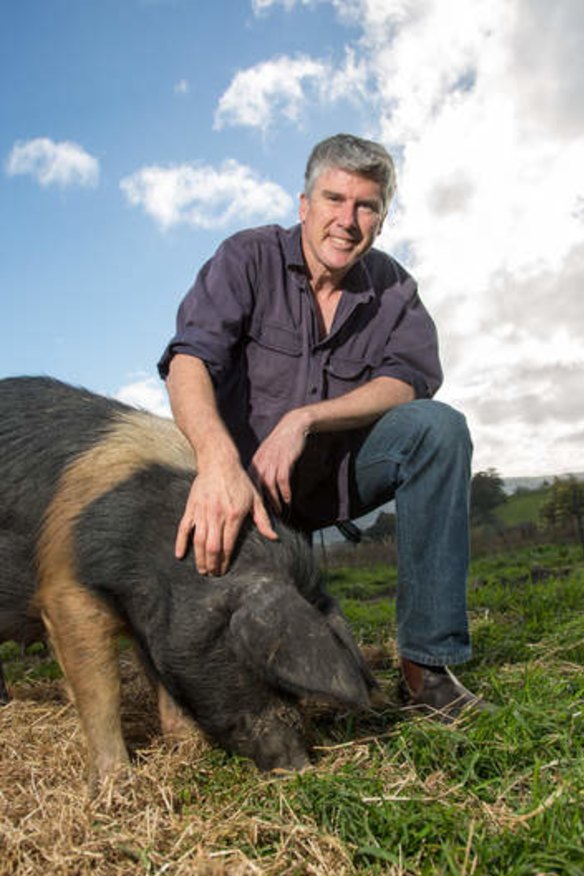Turning his back on Big Food
<i>Gourmet Farmer's</i> Matthew Evans has a new crusade.

You'll know Matthew Evans as the gently spoken host of Gourmet Farmer, a kind of awkward natural in the bucolic scenes from his Tasmanian farm. He does, however, have a tough underbelly and it's set to give his television career a harder edge.
Evans has long been an opponent of Big Food, since his time in Sydney when he quit restaurant reviewing and set about researching The Real Food Companion, before his move to Tasmania in 2008.
Now, he's filming a three-part television documentary on Australian seafood, and we speak with him from Cairns airport where he was waiting for a flight home after filming ''ghost nets'' being dragged from the ocean off Arnhem Land. These are nets washed overboard or cut from fishing boats that get stuck on reefs or in mangrove swamps, where they trap sea life.
Seventy per cent of the seafood we eat in Australia is imported, he says, and when he visits co-ops in fishing villages here all he can buy is frozen, crumbed fish fillets. In Italy, he has watched people pedal as fast as they can to meet fishing boats arriving back to shore, and buying ''every octopus, sardine, pipi, sardine, anchovy, herring''. In contrast, we're sending our top-shelf seafood overseas.
Evans is speaking ahead of the release today of his new book, The Dirty Chef (Allen and Unwin, $30), an anecdotal account of his move that paints quite a romantic picture of a life he patently loves (working in the vegie garden is ''one of the best things I've ever done for my soul''). But it's also a book with plenty of hard-nosed criticism about the state of Australian food.
As he considers taking a lead in some of the tougher food issues, top of the pile is caged hens - ''industrial agriculture's greatest shame''. He recalls the chooks of his childhood in Weston, Canberra, so much a part of the family that they were packed in a sack in the car for beach holidays.
If you are more comfortable not eating meat, but eat eggs you buy from a shop, you must understand that baby roosters die for you to do so.
''I loved the chooks, and I loved their eggs so much that at that tender age I decided I wanted to be a chicken farmer,'' he writes.
''Until I learnt exactly what that meant. Caged hens. Toxic-smelling sheds, routine prophylactic antibiotic use. A complete cull of all chooks after one year on the lay.''
Consumers are duped by terms like free-range, which have no set definition, he says, insisting that animal husbandry should not be left to the free market: ''Customers tend to choose on price. Decisions such as whether we should have cage eggs or feedlotted cattle or sow stalls or pesticide-sprayed crops have to be made as a society, long before cheap meat and veg reaches the shops. By that stage all thoughts of the rights and wrongs have evaporated under the fluorescent lights.''

Evans's distrust of industrial food was fuelled by encounters with farmers while working on The Real Food Companion, like the farmer who fed growth hormones to cattle destined for the shops but raised hormone-free cattle for his own family.
Or the chickpea grower to whom he suggested eating chickpeas straight from the pod. ''The farmer replied, 'What?!' in a very unambiguous manner. 'Eat them? Have you seen what we spray them with?'''
''Why should I trust people who only grow things to sell, rather than growing them to eat?'' he asks.

If Evans' path to farm produce began before he left Sydney, he confronted the reality of farming in Tasmania - a hard job made tougher by his naivety, and one that would pay his way if it wasn't for his writing and television career alongside.
In his account of the struggles, mishaps and joys of farm life, he recounts the frustration of trying to move a reluctant pig, the challenge of getting chooks that breed, the intrusion of wildlife - quolls in the chook pen, wallabies wintering off his pasture, the rain that turns land to mud in winter.
The tragedies are felt deeply. When his first cow, Maggie, dies of mastitis, he is left ''dazed, shocked and grieving'', wondering whether he is cut out for farming. ''If you lose an animal, you question your ability to care for livestock, and you question yourself … My wife and I looked at each other and said 'should we do this?'''
Evans describes himself as still playing at farming, working slower and less efficiently than he should, partly because he does so many different things, rather than specialising.
''There's a reason why farms don't look like Old MacDonald's farm, which is what we want our farm to look like, and that is that everything has a layer of complexity.''
Nor does the farm pay its way. He can earn a living from it but it doesn't pay his two mortgages. If you watch his show, you won't easily forget the uneasy side of this life - the death of animals. More than once in his book, Evans defends his decision to raise and kill animals, but he hasn't found it easy to get used to. His chickens are dispatched in a killing cone that holds the birds upside down, a process he finds ''scary and grim and awful and fascinating all at once''.
''I didn't rejoice in the death then, and I don't now. But I do know that little we do as a species - be it house, clothe or feed ourselves - comes without some impact on animals. What is right for me - and I've just beheaded 15 chickens as I write - may not be right for you.
"If you are more comfortable not eating meat, but eat eggs you buy from a shop, you must understand that baby roosters die for you to do so. If you drink milk, the boy calves are often killed in the first few days or weeks or life, just to keep a cow lactating. If you're a vegan it could well be that someone shot possums just so you can eat apples.''
On his show, Evans filmed a pig killed on the farm instead of the abattoir, and while he lay awake the night before with ''a strange heavy dread in my heart'', he seems to have taken some comfort in the fact that this is an annual ritual for many cultures, and now also on his farm. He has no problem if son Hedley, four, is there.
''I think it will be great for him to be part of that. I think it's a really important part of the philosophy, what we do on our property.
"I have friends who have done it and their children have become vegetarian - and that's great. I think that's a fantastic outcome. If people are horrified and mortified and believe it's too awful for words, they shouldn't eat meat.''
Matthew Evans on veal:
''The veal you get in Australia is usually rose veal, where the calf has been on milk but has access to the outdoors, to a herd for company, and to grass.
''If you drink milk, or eat cheese, or use butter, but don't want people to have rose veal, animals will die at a few days old, rather than a few months. Either way, if you use dairy products, those animals will die.
''I'd argue that it's better to get more meat, and give the animal more life, and eat veal or vealers (six to 12 months), than to kill the beasts at a week old to feed to your dog.''
On pork:
''As piggeries became more intensive, as breeders focused more on faster-growing, leaner breeds that could handle high stocking rates, pork quality … declined. Consumers, duped into rejecting fat, found that this new fast-growing pork was dry and mealy and unappetising.
''The industrial farmer's response to this … was not to look at breeds. Their responses didn't consider the feed or the intensive housing. No, when consumers found pork dry and tasteless, the industry just starting injecting it with salty water … Goodbye flavour, hello profit."
Smoked fish
All you need for this is a heat source and a way to keep the smoke in - it's a very imprecise thing, one you'll learn more about every time you give it a crack. This recipe uses a wok. You'll need a cake rack or similar that fits inside the wok, and a lid or a bowl that can be used to hold the smoke in. If you don't have an exhaust fan, you may want to use a barbecue or similar.
Brine
The best brines for fish are about 10 per cent salt - so 100 grams of salt for every litre of water. This brine can cure small fillets in a few hours, overnight for fatter fillets.
125g sea salt in 1.25L water
2 tsp brown sugar
1-2 slices lemon
500g fish, try blue-eye fillet to start
Tea-smoking mixture
4 tbsp fine black tea
zest of ¼ orange or dried mandarin peel from an Asian grocer
½ cinnamon quill, crumbled up
For the brine, mix the salt, water, sugar and lemon together, heating if necessary to dissolve the salt and sugar. Cool. Immerse two-centimetre thick fillets or a whole plate-sized trout for about four hours (longer for bigger fish). Drain and pat dry. Lay fish on a lightly oiled rack.
Mix up the tea, rind and cinnamon. Line the base of a wok with foil and heat for about 10 minutes over a very high flame. Add the tea mix to the wok and quickly put the rack with the fish over the top, then pop on the lid or cover with a bowl, sealing gaps with foil if need be. Leave on the heat to smoke for about 10 minutes or until the fish is cooked. The fish may not look well coloured from the smoke - but it will have taken up the flavour. Cool on the rack before removing and flaking through a salad or mixing through mash or making into fish pie.
Feta cheese
Makes about 800g
I've simplified this recipe from the one my cheesemaker mate Nick Haddow put in our Gourmet Farmer Deli Book. This uses cow's milk, but you can substitute goat's milk. You need a thermometer. Be sure to use sterile implements and bowls at all times.
5 litres unhomogenised milk
2 tbsp live natural yoghurt
1.25g (1/4 tsp) rennet (from cheesemakers suppliers, such as Cheeselinks online), whisked into 250ml boiled then cooled water
about 5 tbsp (100g) salt
clean muslin (cheesecloth), or use a new Chux
Heat the milk in a large saucepan over low flame, stirring regularly to prevent it catching, until it reaches 32C. You want to keep it close to 32C for as long as possible, so half-fill an Eski or the sink with warm water and sit the pot in it. Add the yoghurt and mix to combine, then allow to sit for an hour. Add the rennet mixture to the milk and stir thoroughly for three seconds. Use your spoon or whisk to stop the milk from moving (you need it completely still while the junket is working). Cover and leave in the Eski for eight to 12 hours, or overnight - do not disturb during this time.
Once the curds are set, use a long knife such as a bread knife to cut the curd into 1cm square by slicing vertically in one direction, then again at right angles. Then hold your knife at an angle and cut through the curd as much as you can from the side to create roughl 1cm cubes or equivalent.
Allow the curds to sit for 10 minutes, then gently stir the curds to stop them from knitting back together, stirring with a spoon every five minutes for the next 30 minutes. Line a colander with a few layers of muslin, leaving enough to cover the top of the cheese, too, and drain the curds through it and wrap the cheesecloth over the top.
Put a plate on top that will cover most of the cheese and top with about 1kg of weight. I use a jar of tomatoes from the pantry. Leave overnight, then cut into cubes and brine.
To make a brine, mix the salt and 1.5 litres of water, stirring to dissolve the salt. Pop the cheese in a sterile jar, top up with brine and leave a day before using. The cheese should last a week or two, and will get saltier with time.
Restaurant reviews, news and the hottest openings served to your inbox.
Sign up